Concept Art
Concept art is a form of illustration where the main goal is to convey a visual representation of a design, idea, and/or mood for use in films, video games, animation, or comic books
before it is put into the final product. Concept art is also referred
to as visual development and/or concept design. This term can also be
applied to retail design, set design, fashion design and architectural
design.
A concept artist is an individual who generates a visual design for an
item, character, or area that does not yet exist. This includes, but is
not limited to, film production, animation production and more recently
video game production. A concept artist may be required for nothing more
than preliminary artwork, or may be required to be part of a creative
team until a project reaches fruition. While it is necessary to have the
skills of a fine artist, a concept artist must also be able to work to
strict deadlines in the capacity of a graphic designer.
Some concept artists may start as fine artists, industrial designers,
animators, or even special effects artists. Interpretation of ideas and
how they are realized is where the concept artist's individual
creativity is most evident, as subject matter is often beyond their
control.
Concept art ranges from photorealistic to traditional painting techniques. This is facilitated by the use of special software by which an artist is able to fill in even small details pixel
by pixel, or utilise the natural paint settings to imitate real paint.
When commissioning work, a company will often require a large amount of
preliminary work to be produced. Artists working on a project often
produce a large turnover in the early stages to provide a broad range of
interpretations, most of this being in the form of sketches, speed paints, and 3D overpaints. Later pieces of concept art, like matte paintings, are produced as realistically as required.
The two most widely covered themes in concept art are science fiction and fantasy. Concept art has always had to cover many subjects, being the primary medium in film poster design since the early days of Hollywood, however, since the recent rise of concept art used in video game production concept art has expanded to cover genres from football to the Mafia and beyond.
I really like this piece of artwork, this piece of work is inspiring in my opinion. And i would like to do something like this for my piece of work. I couldn't find the artist who designed this game character.
Stephen Chang
Concept artist Stephen Chang has released some great concept artwork he created for Star Wars: The Force Unleashed I & II. Stephen Chang is currently working at LucasArts as a senior concept artist.
Link: stevoskit.com
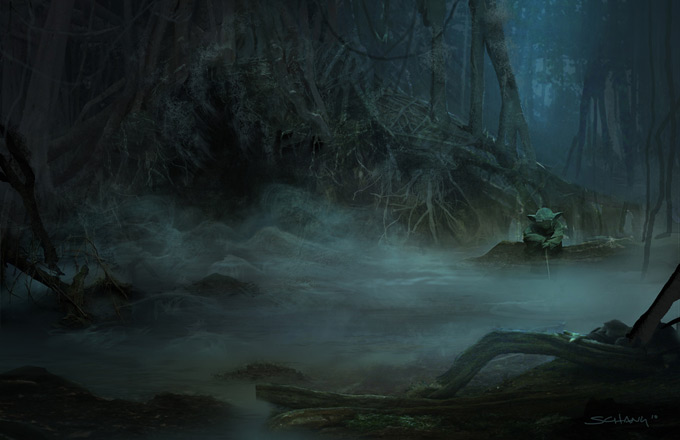


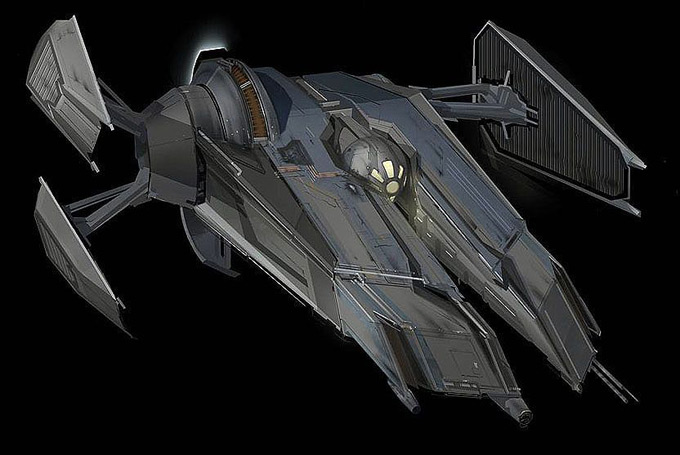
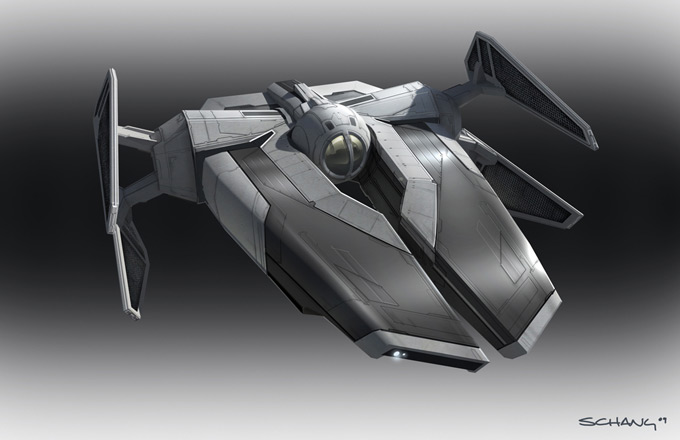
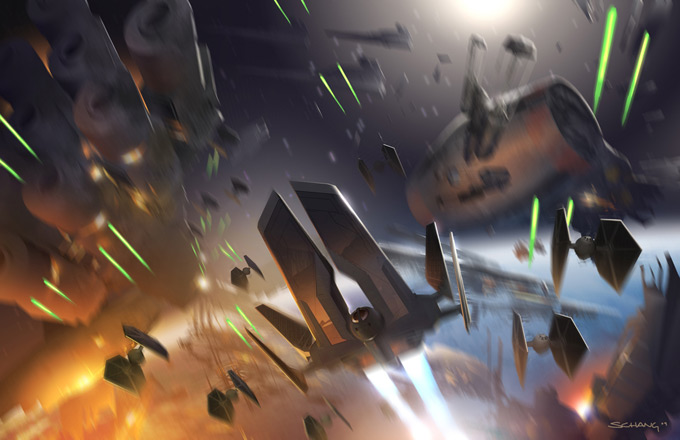
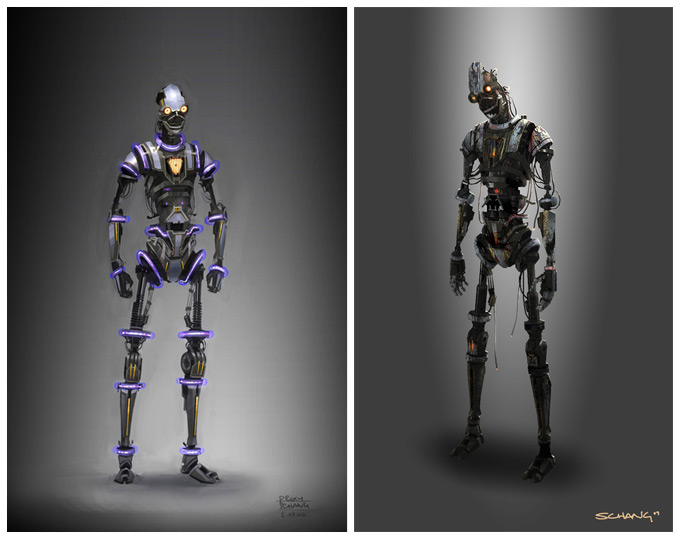

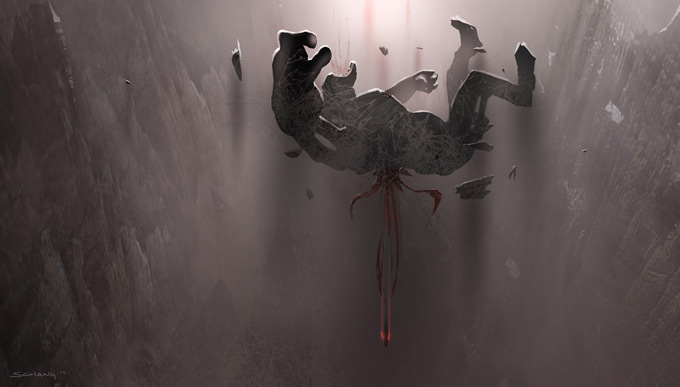
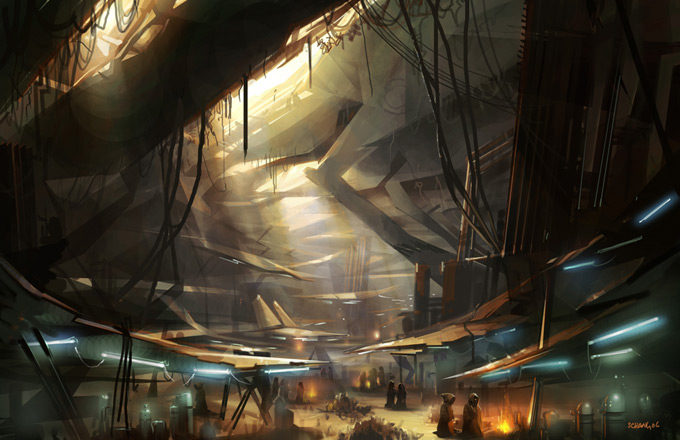
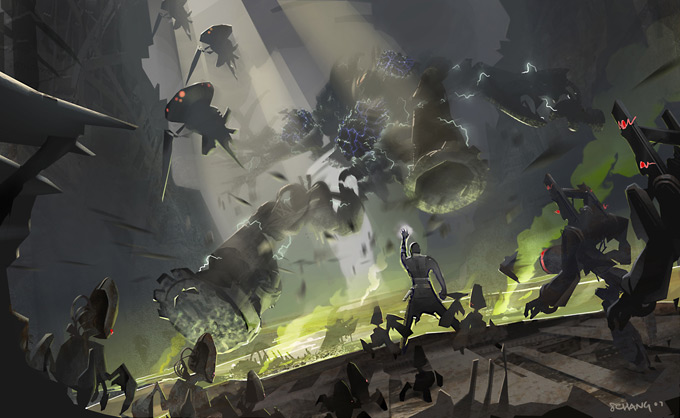
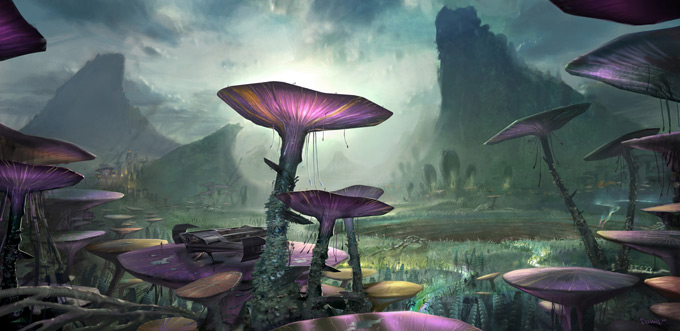

Paul Richards
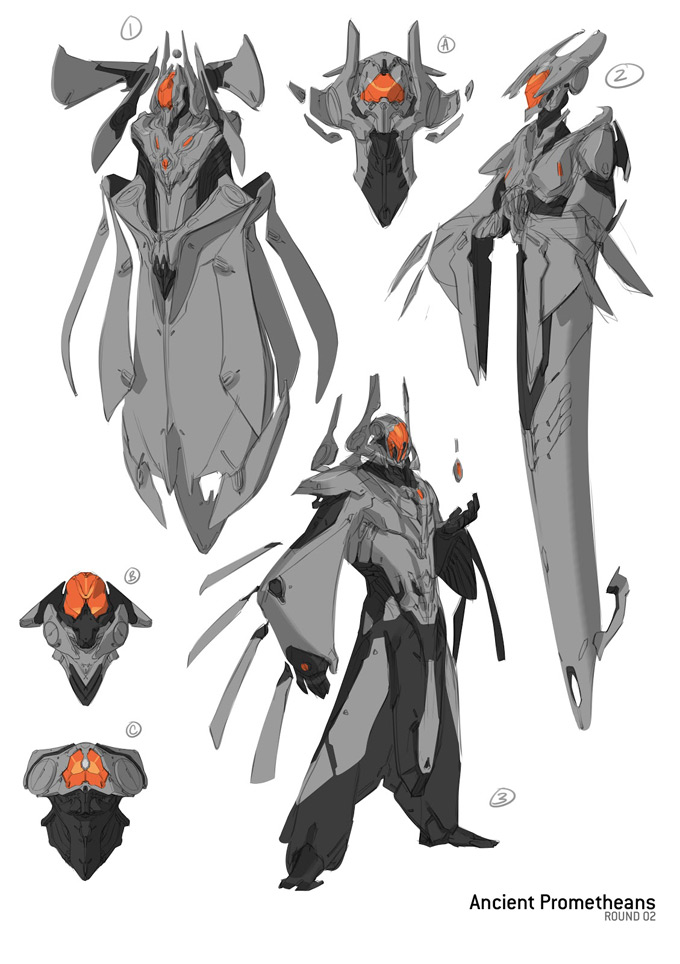


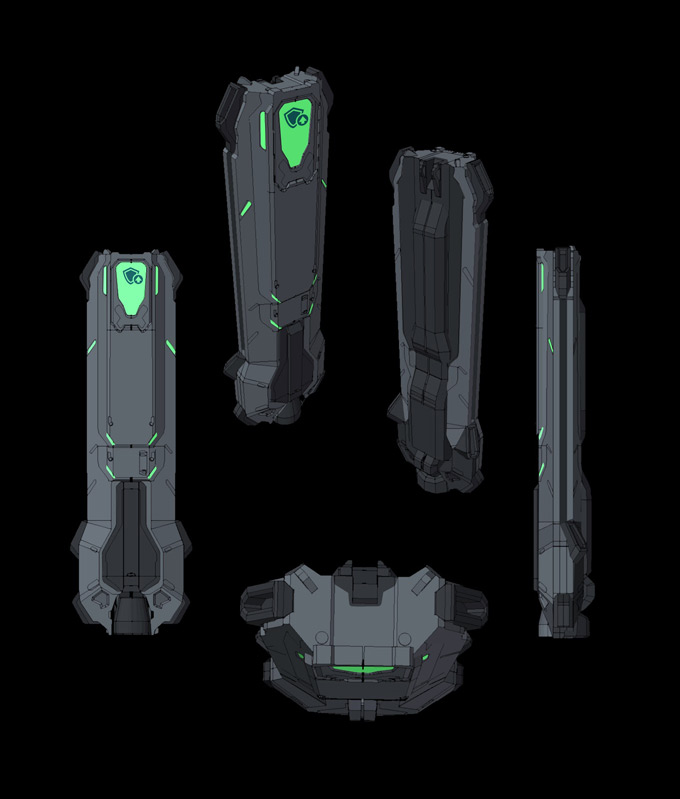
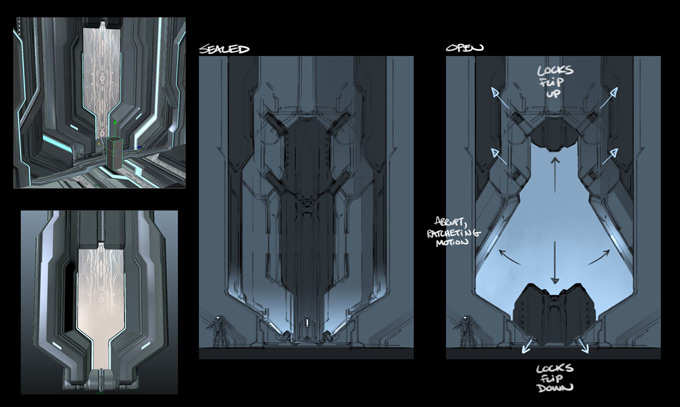
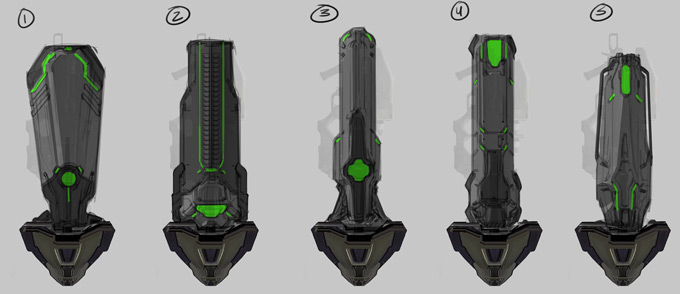

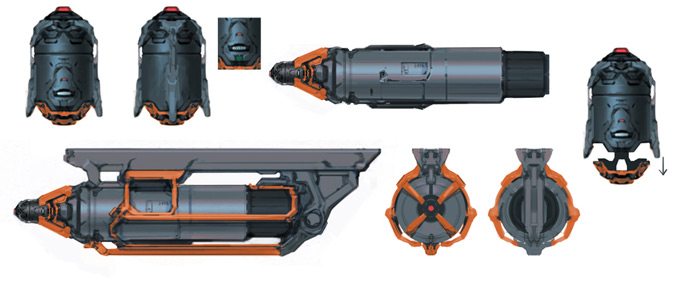
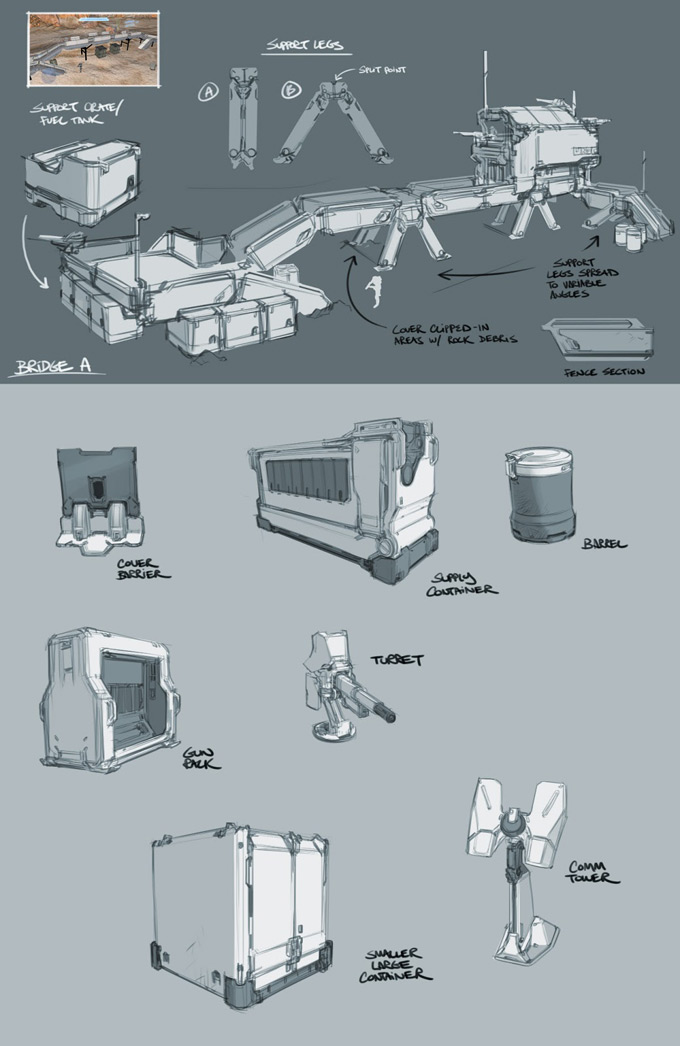
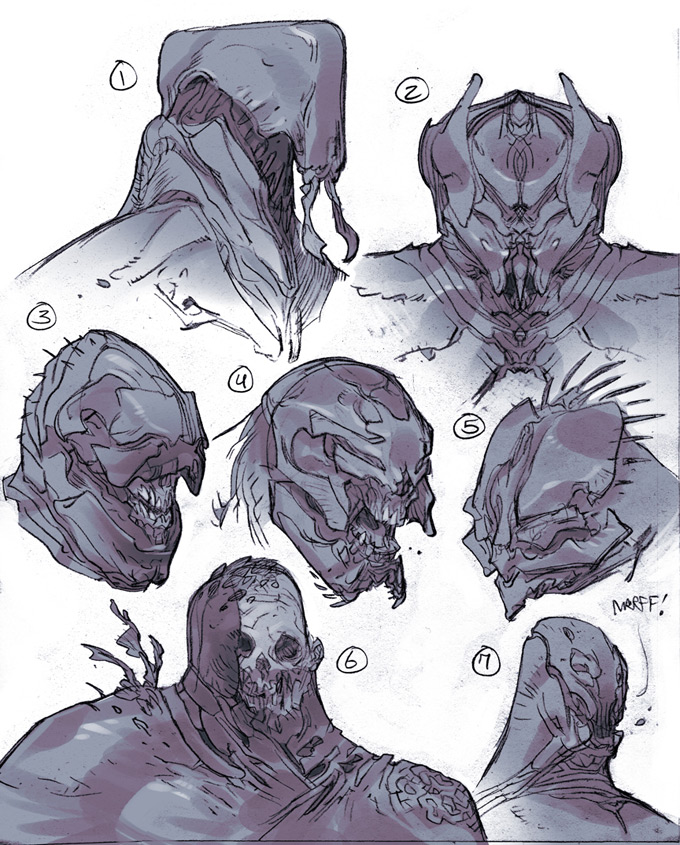
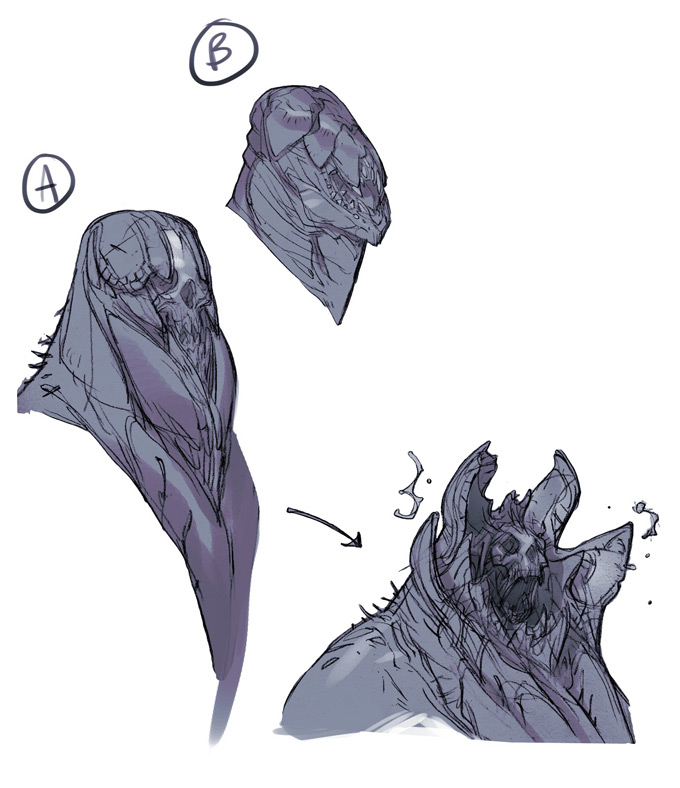
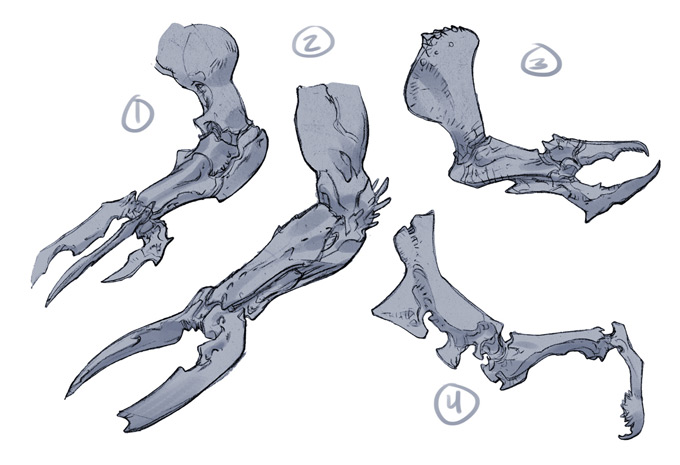


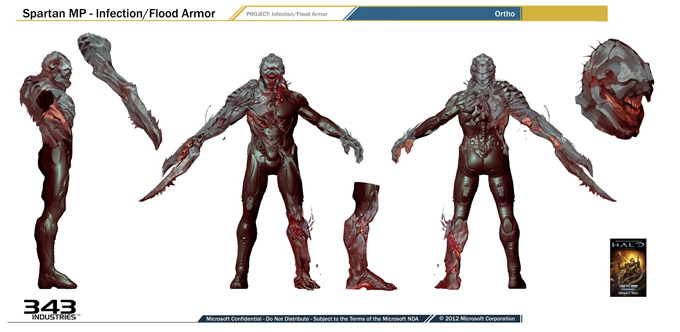


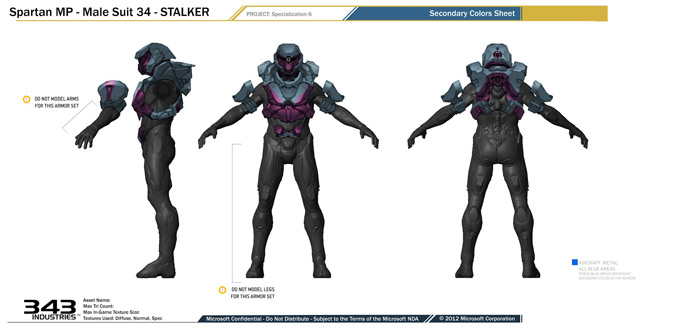

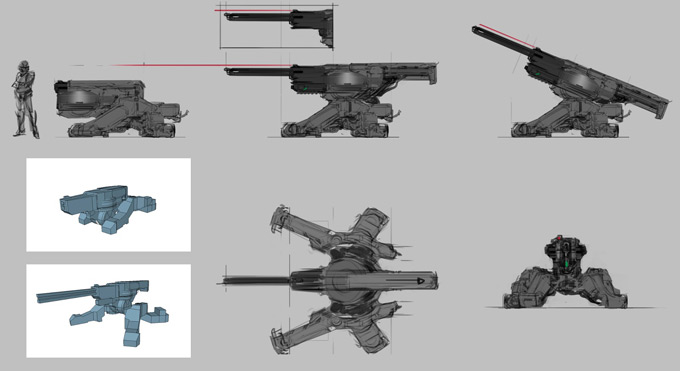
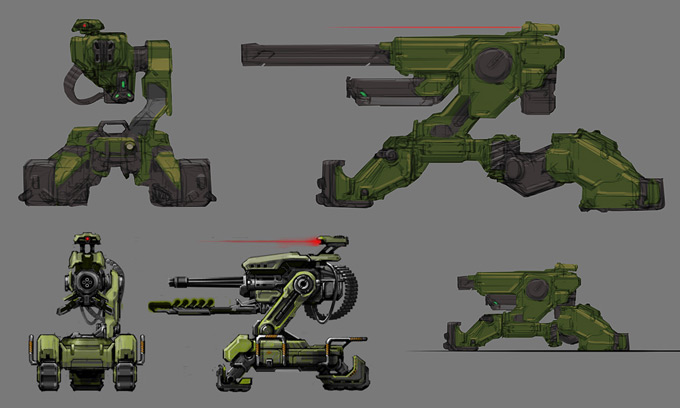




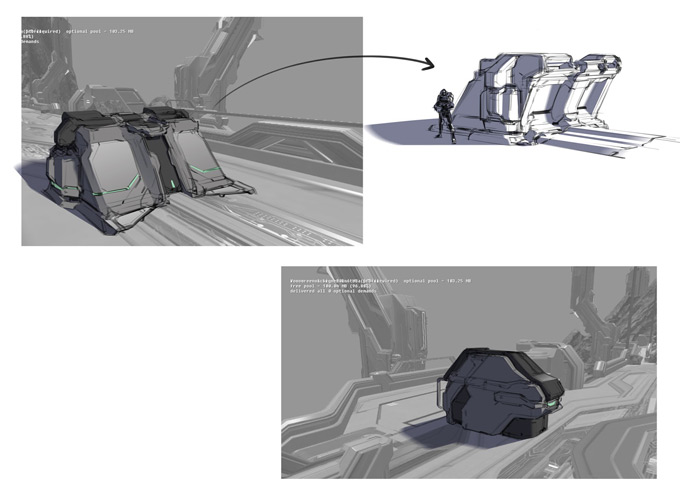
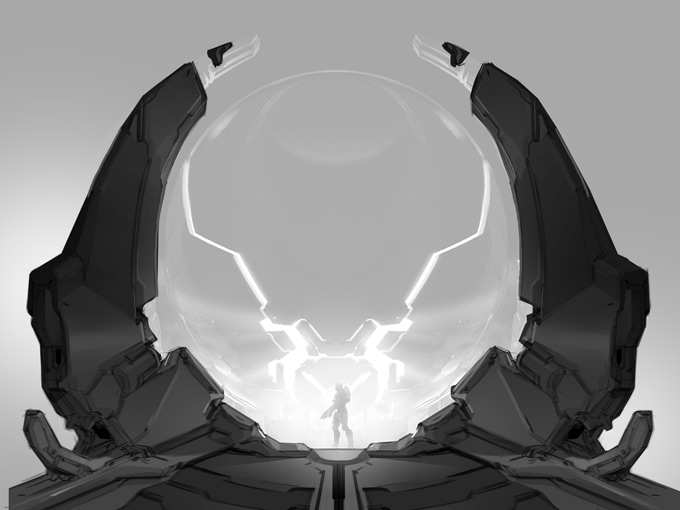































 Concept Art Illustration for Transformers 3: Dark of the Moon movie. Copyright 2011 Paramont Pictures and Josh Nizzi. All right reserved.
Concept Art Illustration for Transformers 3: Dark of the Moon movie. Copyright 2011 Paramont Pictures and Josh Nizzi. All right reserved.
 Concept Art Illustration for Transformers 3: Dark of the Moon movie. Copyright 2011 Paramont Pictures and Josh Nizzi. All right reserved.
Concept Art Illustration for Transformers 3: Dark of the Moon movie. Copyright 2011 Paramont Pictures and Josh Nizzi. All right reserved.
 Concept Art Illustration for Transformers 3: Dark of the Moon movie. Copyright 2011 Paramont Pictures and Josh Nizzi. All right reserved.
Concept Art Illustration for Transformers 3: Dark of the Moon movie. Copyright 2011 Paramont Pictures and Josh Nizzi. All right reserved.
 Concept Art Illustration for Transformers 3: Dark of the Moon movie. Copyright 2011 Paramont Pictures and Josh Nizzi. All right reserved.
Concept Art Illustration for Transformers 3: Dark of the Moon movie. Copyright 2011 Paramont Pictures and Josh Nizzi. All right reserved.
 Concept Art Illustration for Transformers 3: Dark of the Moon movie. Copyright 2011 Paramont Pictures and Josh Nizzi. All right reserved.
Concept Art Illustration for Transformers 3: Dark of the Moon movie. Copyright 2011 Paramont Pictures and Josh Nizzi. All right reserved.
 Concept Art Illustration for Transformers 3: Dark of the Moon movie. Copyright 2011 Paramont Pictures and Josh Nizzi. All right reserved.
Concept Art Illustration for Transformers 3: Dark of the Moon movie. Copyright 2011 Paramont Pictures and Josh Nizzi. All right reserved.
 Concept Art Illustration for Transformers 3: Dark of the Moon movie. Copyright 2011 Paramont Pictures and Josh Nizzi. All right reserved.
Concept Art Illustration for Transformers 3: Dark of the Moon movie. Copyright 2011 Paramont Pictures and Josh Nizzi. All right reserved.
 Concept Art Illustration for Transformers 3: Dark of the Moon movie. Copyright 2011 Paramont Pictures and Josh Nizzi. All right reserved.
Concept Art Illustration for Transformers 3: Dark of the Moon movie. Copyright 2011 Paramont Pictures and Josh Nizzi. All right reserved.
 Concept Art Illustration for Transformers 3: Dark of the Moon movie. Copyright 2011 Paramont Pictures and Josh Nizzi. All right reserved.
Concept Art Illustration for Transformers 3: Dark of the Moon movie. Copyright 2011 Paramont Pictures and Josh Nizzi. All right reserved.
 Concept Art Illustration for Transformers 3: Dark of the Moon movie. Copyright 2011 Paramont Pictures and Josh Nizzi. All right reserved.
Concept Art Illustration for Transformers 3: Dark of the Moon movie. Copyright 2011 Paramont Pictures and Josh Nizzi. All right reserved.
 Concept Art Illustration for Transformers 3: Dark of the Moon movie. Copyright 2011 Paramont Pictures and Josh Nizzi. All right reserved.
Concept Art Illustration for Transformers 3: Dark of the Moon movie. Copyright 2011 Paramont Pictures and Josh Nizzi. All right reserved.
 Concept Art Illustration for Transformers 3: Dark of the Moon movie. Copyright 2011 Paramont Pictures and Josh Nizzi. All right reserved.
Concept Art Illustration for Transformers 3: Dark of the Moon movie. Copyright 2011 Paramont Pictures and Josh Nizzi. All right reserved.
 Concept Art Illustration for Transformers 3: Dark of the Moon movie. Copyright 2011 Paramont Pictures and Josh Nizzi. All right reserved.
Concept Art Illustration for Transformers 3: Dark of the Moon movie. Copyright 2011 Paramont Pictures and Josh Nizzi. All right reserved.
 Concept Art Illustration for Transformers 3: Dark of the Moon movie. Copyright 2011 Paramont Pictures and Josh Nizzi. All right reserved.
Concept Art Illustration for Transformers 3: Dark of the Moon movie. Copyright 2011 Paramont Pictures and Josh Nizzi. All right reserved.
 Concept Art Illustration for Transformers 3: Dark of the Moon movie. Copyright 2011 Paramont Pictures and Josh Nizzi. All right reserved.
Concept Art Illustration for Transformers 3: Dark of the Moon movie. Copyright 2011 Paramont Pictures and Josh Nizzi. All right reserved.
 Concept Art Illustration for Transformers 3: Dark of the Moon movie. Copyright 2011 Paramont Pictures and Josh Nizzi. All right reserved.
Concept Art Illustration for Transformers 3: Dark of the Moon movie. Copyright 2011 Paramont Pictures and Josh Nizzi. All right reserved.
 Concept Art Illustration for Transformers 3: Dark of the Moon movie. Copyright 2011 Paramont Pictures and Josh Nizzi. All right reserved.
Concept Art Illustration for Transformers 3: Dark of the Moon movie. Copyright 2011 Paramont Pictures and Josh Nizzi. All right reserved.
 Concept Art Illustration for Transformers 3: Dark of the Moon movie. Copyright 2011 Paramont Pictures and Josh Nizzi. All right reserved.
Concept Art Illustration for Transformers 3: Dark of the Moon movie. Copyright 2011 Paramont Pictures and Josh Nizzi. All right reserved.
 Concept Art Illustration for Transformers 3: Dark of the Moon movie. Copyright 2011 Paramont Pictures and Josh Nizzi. All right reserved.
Concept Art Illustration for Transformers 3: Dark of the Moon movie. Copyright 2011 Paramont Pictures and Josh Nizzi. All right reserved.
 Concept Art Illustration for Transformers 3: Dark of the Moon movie. Copyright 2011 Paramont Pictures and Josh Nizzi. All right reserved.
Concept Art Illustration for Transformers 3: Dark of the Moon movie. Copyright 2011 Paramont Pictures and Josh Nizzi. All right reserved.
 Concept Art Illustration for Transformers 3: Dark of the Moon movie. Copyright 2011 Paramont Pictures and Josh Nizzi. All right reserved.
Concept Art Illustration for Transformers 3: Dark of the Moon movie. Copyright 2011 Paramont Pictures and Josh Nizzi. All right reserved.
 Concept Art Illustration for Transformers 3: Dark of the Moon movie. Copyright 2011 Paramont Pictures and Josh Nizzi. All right reserved.
Concept Art Illustration for Transformers 3: Dark of the Moon movie. Copyright 2011 Paramont Pictures and Josh Nizzi. All right reserved.
 Concept Art Illustration for Transformers 3: Dark of the Moon movie. Copyright 2011 Paramont Pictures and Josh Nizzi. All right reserved.
Concept Art Illustration for Transformers 3: Dark of the Moon movie. Copyright 2011 Paramont Pictures and Josh Nizzi. All right reserved.
 Concept Art Illustration for Transformers 3: Dark of the Moon movie. Copyright 2011 Paramont Pictures and Josh Nizzi. All right reserved.
Concept Art Illustration for Transformers 3: Dark of the Moon movie. Copyright 2011 Paramont Pictures and Josh Nizzi. All right reserved.
 Concept Art Illustration for Transformers 3: Dark of the Moon movie. Copyright 2011 Paramont Pictures and Josh Nizzi. All right reserved.
Concept Art Illustration for Transformers 3: Dark of the Moon movie. Copyright 2011 Paramont Pictures and Josh Nizzi. All right reserved.
 Concept Art Illustration for Transformers 3: Dark of the Moon movie. Copyright 2011 Paramont Pictures and Josh Nizzi. All right reserved.
Concept Art Illustration for Transformers 3: Dark of the Moon movie. Copyright 2011 Paramont Pictures and Josh Nizzi. All right reserved.
 Concept Art Illustration for Transformers 3: Dark of the Moon movie. Copyright 2011 Paramont Pictures and Josh Nizzi. All right reserved.
Concept Art Illustration for Transformers 3: Dark of the Moon movie. Copyright 2011 Paramont Pictures and Josh Nizzi. All right reserved.









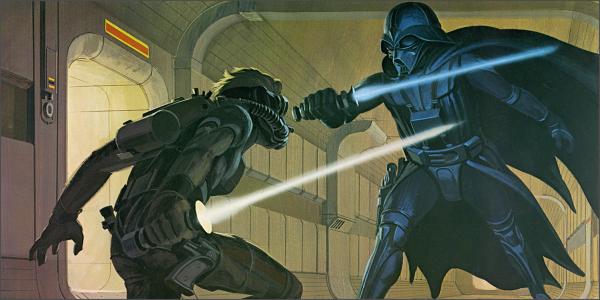

The two most widely covered themes in concept art are science fiction and fantasy. Concept art has always had to cover many subjects, being the primary medium in film poster design since the early days of Hollywood, however, since the recent rise of concept art used in video game production concept art has expanded to cover genres from football to the Mafia and beyond.
I really like this piece of artwork, this piece of work is inspiring in my opinion. And i would like to do something like this for my piece of work. I couldn't find the artist who designed this game character.
Stephen Chang
Concept artist Stephen Chang has released some great concept artwork he created for Star Wars: The Force Unleashed I & II. Stephen Chang is currently working at LucasArts as a senior concept artist.
Link: stevoskit.com












This is my personal favourite piece of his artwork, i really like detail and the colour used, i am also a of machine characters for concept art this is probably why i am really interested in this exact piece of work.

Paul Richards
Paul richards is one of the Halo concept artists, while working at 343 Industries. Paul has also worked for companies such as ION Storm, id Software, 3D Realms, Ritual Entertainment, Raven Software, Vigil Games and Blizzard Entertainment. his work is possibly the most enspiring simply because loads of people love halo and love the artwork.



























Isaac Hannaford
Isaac Hannaford also did concept art for halo, mainly for halo 3. He has a job some of us would die for. Well not die, because it would mean you
cannot work anymore. You see my point. Anyway he was concept artist for the Halo
saga. As I’m a huge fan of Halo, i really like this type of concept art more than anyother. I personally reckon that his artworks is much better that Paul Richards.































 Concept Art Illustration for Transformers 3: Dark of the Moon movie. Copyright 2011 Paramont Pictures and Josh Nizzi. All right reserved.
Concept Art Illustration for Transformers 3: Dark of the Moon movie. Copyright 2011 Paramont Pictures and Josh Nizzi. All right reserved.Blitzwing Moody Version ( Josh Nizzi )
 Concept Art Illustration for Transformers 3: Dark of the Moon movie. Copyright 2011 Paramont Pictures and Josh Nizzi. All right reserved.
Concept Art Illustration for Transformers 3: Dark of the Moon movie. Copyright 2011 Paramont Pictures and Josh Nizzi. All right reserved.Ultra Magnus ( Josh Nizzi )
 Concept Art Illustration for Transformers 3: Dark of the Moon movie. Copyright 2011 Paramont Pictures and Josh Nizzi. All right reserved.
Concept Art Illustration for Transformers 3: Dark of the Moon movie. Copyright 2011 Paramont Pictures and Josh Nizzi. All right reserved.Dreadwind ( Josh Nizzi )
 Concept Art Illustration for Transformers 3: Dark of the Moon movie. Copyright 2011 Paramont Pictures and Josh Nizzi. All right reserved.
Concept Art Illustration for Transformers 3: Dark of the Moon movie. Copyright 2011 Paramont Pictures and Josh Nizzi. All right reserved.Dreadwind Protoform ( Josh Nizzi )
 Concept Art Illustration for Transformers 3: Dark of the Moon movie. Copyright 2011 Paramont Pictures and Josh Nizzi. All right reserved.
Concept Art Illustration for Transformers 3: Dark of the Moon movie. Copyright 2011 Paramont Pictures and Josh Nizzi. All right reserved.Rush Head ( Josh Nizzi )
 Concept Art Illustration for Transformers 3: Dark of the Moon movie. Copyright 2011 Paramont Pictures and Josh Nizzi. All right reserved.
Concept Art Illustration for Transformers 3: Dark of the Moon movie. Copyright 2011 Paramont Pictures and Josh Nizzi. All right reserved.Breakdown ( Josh Nizzi )
 Concept Art Illustration for Transformers 3: Dark of the Moon movie. Copyright 2011 Paramont Pictures and Josh Nizzi. All right reserved.
Concept Art Illustration for Transformers 3: Dark of the Moon movie. Copyright 2011 Paramont Pictures and Josh Nizzi. All right reserved.Hooligan ( Josh Nizzi )
 Concept Art Illustration for Transformers 3: Dark of the Moon movie. Copyright 2011 Paramont Pictures and Josh Nizzi. All right reserved.
Concept Art Illustration for Transformers 3: Dark of the Moon movie. Copyright 2011 Paramont Pictures and Josh Nizzi. All right reserved.Hooligan Protoform ( Josh Nizzi )
 Concept Art Illustration for Transformers 3: Dark of the Moon movie. Copyright 2011 Paramont Pictures and Josh Nizzi. All right reserved.
Concept Art Illustration for Transformers 3: Dark of the Moon movie. Copyright 2011 Paramont Pictures and Josh Nizzi. All right reserved.Warpath ( Josh Nizzi )
 Concept Art Illustration for Transformers 3: Dark of the Moon movie. Copyright 2011 Paramont Pictures and Josh Nizzi. All right reserved.
Concept Art Illustration for Transformers 3: Dark of the Moon movie. Copyright 2011 Paramont Pictures and Josh Nizzi. All right reserved.Warpath Protoform ( Josh Nizzi )
 Concept Art Illustration for Transformers 3: Dark of the Moon movie. Copyright 2011 Paramont Pictures and Josh Nizzi. All right reserved.
Concept Art Illustration for Transformers 3: Dark of the Moon movie. Copyright 2011 Paramont Pictures and Josh Nizzi. All right reserved.Tempest ( Josh Nizzi )
 Concept Art Illustration for Transformers 3: Dark of the Moon movie. Copyright 2011 Paramont Pictures and Josh Nizzi. All right reserved.
Concept Art Illustration for Transformers 3: Dark of the Moon movie. Copyright 2011 Paramont Pictures and Josh Nizzi. All right reserved.Tempest Protoform ( Josh Nizzi )
 Concept Art Illustration for Transformers 3: Dark of the Moon movie. Copyright 2011 Paramont Pictures and Josh Nizzi. All right reserved.
Concept Art Illustration for Transformers 3: Dark of the Moon movie. Copyright 2011 Paramont Pictures and Josh Nizzi. All right reserved.Flash With Dog ( Josh Nizzi )
 Concept Art Illustration for Transformers 3: Dark of the Moon movie. Copyright 2011 Paramont Pictures and Josh Nizzi. All right reserved.
Concept Art Illustration for Transformers 3: Dark of the Moon movie. Copyright 2011 Paramont Pictures and Josh Nizzi. All right reserved.Dreadlock Decepticon ( Josh Nizzi )
 Concept Art Illustration for Transformers 3: Dark of the Moon movie. Copyright 2011 Paramont Pictures and Josh Nizzi. All right reserved.
Concept Art Illustration for Transformers 3: Dark of the Moon movie. Copyright 2011 Paramont Pictures and Josh Nizzi. All right reserved.Dirtbag ( Josh Nizzi )
 Concept Art Illustration for Transformers 3: Dark of the Moon movie. Copyright 2011 Paramont Pictures and Josh Nizzi. All right reserved.
Concept Art Illustration for Transformers 3: Dark of the Moon movie. Copyright 2011 Paramont Pictures and Josh Nizzi. All right reserved.Dirtbag Protoform ( Josh Nizzi )
 Concept Art Illustration for Transformers 3: Dark of the Moon movie. Copyright 2011 Paramont Pictures and Josh Nizzi. All right reserved.
Concept Art Illustration for Transformers 3: Dark of the Moon movie. Copyright 2011 Paramont Pictures and Josh Nizzi. All right reserved.Megatron in Africa ( Josh Nizzi )
 Concept Art Illustration for Transformers 3: Dark of the Moon movie. Copyright 2011 Paramont Pictures and Josh Nizzi. All right reserved.
Concept Art Illustration for Transformers 3: Dark of the Moon movie. Copyright 2011 Paramont Pictures and Josh Nizzi. All right reserved.Megatron Ground Pound ( Josh Nizzi )
 Concept Art Illustration for Transformers 3: Dark of the Moon movie. Copyright 2011 Paramont Pictures and Josh Nizzi. All right reserved.
Concept Art Illustration for Transformers 3: Dark of the Moon movie. Copyright 2011 Paramont Pictures and Josh Nizzi. All right reserved.Megatron Africa Camp ( Josh Nizzi )
 Concept Art Illustration for Transformers 3: Dark of the Moon movie. Copyright 2011 Paramont Pictures and Josh Nizzi. All right reserved.
Concept Art Illustration for Transformers 3: Dark of the Moon movie. Copyright 2011 Paramont Pictures and Josh Nizzi. All right reserved.Megatron Africa Camp ( Josh Nizzi )
 Concept Art Illustration for Transformers 3: Dark of the Moon movie. Copyright 2011 Paramont Pictures and Josh Nizzi. All right reserved.
Concept Art Illustration for Transformers 3: Dark of the Moon movie. Copyright 2011 Paramont Pictures and Josh Nizzi. All right reserved.Blitzwing ( Josh Nizzi )
 Concept Art Illustration for Transformers 3: Dark of the Moon movie. Copyright 2011 Paramont Pictures and Josh Nizzi. All right reserved.
Concept Art Illustration for Transformers 3: Dark of the Moon movie. Copyright 2011 Paramont Pictures and Josh Nizzi. All right reserved.Colossus ( Josh Nizzi )
 Concept Art Illustration for Transformers 3: Dark of the Moon movie. Copyright 2011 Paramont Pictures and Josh Nizzi. All right reserved.
Concept Art Illustration for Transformers 3: Dark of the Moon movie. Copyright 2011 Paramont Pictures and Josh Nizzi. All right reserved.Transformer Killer Squad ( Josh Nizzi )
 Concept Art Illustration for Transformers 3: Dark of the Moon movie. Copyright 2011 Paramont Pictures and Josh Nizzi. All right reserved.
Concept Art Illustration for Transformers 3: Dark of the Moon movie. Copyright 2011 Paramont Pictures and Josh Nizzi. All right reserved.Decepticon Fighter ( Josh Nizzi )
 Concept Art Illustration for Transformers 3: Dark of the Moon movie. Copyright 2011 Paramont Pictures and Josh Nizzi. All right reserved.
Concept Art Illustration for Transformers 3: Dark of the Moon movie. Copyright 2011 Paramont Pictures and Josh Nizzi. All right reserved.Decepticon Fighter ( Josh Nizzi )
 Concept Art Illustration for Transformers 3: Dark of the Moon movie. Copyright 2011 Paramont Pictures and Josh Nizzi. All right reserved.
Concept Art Illustration for Transformers 3: Dark of the Moon movie. Copyright 2011 Paramont Pictures and Josh Nizzi. All right reserved.Decepticon Fighter ( Josh Nizzi )
 Concept Art Illustration for Transformers 3: Dark of the Moon movie. Copyright 2011 Paramont Pictures and Josh Nizzi. All right reserved.
Concept Art Illustration for Transformers 3: Dark of the Moon movie. Copyright 2011 Paramont Pictures and Josh Nizzi. All right reserved.Decepticon Fighter ( Josh Nizzi )











Hitler never saw it coming. The four-picture progression cleverly relives the epic ending of Bionic Commando when Master-D (we all know it was Hitler) is destroyed. Ah, what a moment-- now preserved eternally in all its 8-bit splendor.
| |||
 |  |  |  |
8 Bit Justice
| |||
Mastermind of pixilated pop art, Chris Olan AKA 8-Bit Artist, has made a name for himself in the realm of video game-inspired art. COIN-OP TV and RetroBlast take an inside look at Olan’s talents and inspiration.
| |||
 |
How long have you been pursuing art, and how did you develop this unique style? “I’ve been painting for a little over a year now. My birthday was coming up, and my friend, an artist, asked me what I wanted. I told her I wanted a Mega Man piece done, but unfortunately, she got busy and couldn’t do it for me. I wanted the piece so much, I just decided to do it myself. I fell in love with how the sprite came out using just paints. After that, it is all I ever wanted to paint.”
|
“My inspiration is of course both the NES and my childhood. I have such fond memories of it growing up. The wonderful and colorful characters of the NES is what really influenced my painting. I love capturing a moment of a game on canvas and having people get taken back to that time when they didn’t have a care in the world and their biggest worry was trying to save the princess.” |  |
How would you describe your style? “I've had people call my art lots of things: Pixelism, Pop Art, Neo-Dada Art and of course, Crap. I guess one could call it Pop Art since the NES is a pop icon, but I don't worry about a certain style or anything. If someone came up to me and asked me what I painted, I just smile and say, ‘I paint squares.’"
|
 |
 |
Do you think the relationship between art and video games will develop further in the future? “Absolutely. No matter how cool the gameplay or how well the game is done, if you don't have cool stuff to look at or have characters that don't stick in your head the game won't be as successful as it can be. The early NES games like Mario, Zelda, Metroid, Kid Icarus; they had such memorable characters, scenes, backgrounds, etc. It just enhanced the experience and that won't ever leave video games.”
|
Do you think retro gaming and style is making a comeback? Is it gaining popularity? “I think retro gaming is making a comeback, I mean, just look at all the different type of Nintendo shirts Hot Topic has! It has steadily been gaining popularity for while, although it is tough to say exactly why. My personal reason would be that games nowadays are much too complicated. I don't want to pop in Madden 2006 and be the QB and have to control my head, set my feet, and make sure I don't over throw and stuff like that or else my throw won’t be completed. I think it takes the fun out of it. I want to play Tecmo Bowl, be Bo Jackson and just have 25 rushing TD's in one game.”
|  |
 |
Rodney Pygoya Chang
What my presented art mathematical model
professes is that upon the perception of any art object, the complex
interactions of the factors of this equation operate and function to produce a
holistic overall response (or perception) to the aesthetic stimulus. Like a
computer, the mind inputs the data and comes up with a conclusion or
decision as output....The formula for an art making modality also de-emphasizes
the importance of the specific art medium used, freeing the creator to use
whatever material or technology is available for his perusal.

Sailing, Oil on Canvas, 1966

Next Century, Digital, 1985

Interface, Lithograph, 1986

Lover, Digital 1986

Picasso's Bullfight, Digital/Woodcut, 1989

Street Beat, Digital Oil, 1987

Fleeting Love, Revolving Fan/Surgical
Gloves, Photo, Glasses, Penlight, Oral Cotton Rolls, 2 lb. Fishing Line,
1987

Nuclear Moon Glow, Digital/Serigraph, 1986

Outpost, Digital, 1986

Painting on Location, Digital Oil, 2003

Pink Tidal Lights, Digital Giclee, 2003

Portal to Cyberspace, Oil on Canvas, 1997

Go With the Flow, Oil on Canvas, 2003

Assembly, Oil on Canvas, 1986
Karl Lilje
Born in 1972. Living in Cape Town, South Africa, Lilje takes famous photographs and pixelates them using software.
Adam Connelly
"I was born in 1974, in Ann Arbor, Michigan and lived there for sixteen years". "
I have a BFA from UC Santa Cruz where I studied painting, printmaking, and
photography, graduating in 1996. Since then, I have worked as a graphic designer
with companies such as Sega, Pixar, CNET, and Apple Computer".
"Specializing in interactive and motion graphics work as a designer has directly influenced my artwork". "It compelled me to examine where the borders of the digital and the analog world meet, and how social, cultural, and ideological trends are shaped by technology and art".
Adam Connelly's was much different to other pixelist artists. What he did was take Pornographic pictures and pixelate them so you couldn't see the picture very well but you are still able to see what the image really is.


 
This is his own website which i found,
http://www.adamconnelly.com/gallery/index.html
Patrick Egarter
Patrick Egarter is the best pixelist artist i have researched so far, he makes pixel pictures by using paint, he makes his art in the same way a pointillist artist would make there artwork. His work takes hours and hours to complete and because of this there are no images of his work, only thumbnails. His work is shown by video, he films himself creating his work.
This is Vimeo account were all of his videos are.
http://vimeo.com/user2571043
Dadaism
Hannah Höch - Brushflurlets and Beer Bellies
Hannah Höch with her Dada Dolls, 1920
Hannah Höch (1889-1978) was born in Gotha. Her father was the director of an insurance company, her mother a hobby painter. Hannah studied at the Kunstgewerbeschule (Arts and Crafts School) in Berlin between 1912 and 1915. She finished her studies under Emil Orlik, concentrating on collage techniques. After her schooling, she worked in the handicrafts department for the Ullstein publishing house, designing dress and embroidery patterns for Die Dame (The Lady) and Die Praktische Berlinerin (The Practical Berlin Woman).
Hannah Höch, The Puppet Balsamine, 1927
She met Dadaist Raoul Hausmann in 1915 and they became close friends. Höch was the only woman participating in the First International Dada Fair which took place at at Dr. Otto Burchard’s Berlin art gallery in July 1920. Among her fellow dadaists were Johannes Baader, George Grosz and John Heartfield. Höch's personal relationship with Hausmann grew from friendship to a temptous romance over time, but they separated in 1922, partly because Höch didn't like Hausmann's insistence on an "official" ménage à trois together with his wife (Hausmann's dream came true in the late 1920s, when he moved with his wife Hedwig and his model Vera Broido to the fashionable district of Charlottenburg).
Raoul Hausmann, Double Portrait Hannah Höch and Raoul Hausmann, c. 1920
Hannah Höch - by now living with a woman, Dutch writer Til Brugmann, left a sketch of Hausmann around 1931: "After I had offered to renew friendly relations we met frequently (with Til as well). At the time he was living with Heda Mankowicz-Hausmann and Vera Broido in Kaiser-Friedrich-Straße in Charlottenburg. Til and I went there often. But I always found it very boring. He was just acting the photographer, and the lover of Vera B, showing off terribly with what he could afford to buy now - the ésprit was all gone."
Hannah Höch, Die starken Männer (The Strong Guys), 1931
Höch observed in an undated note: "None of these men were satisfied with just an ordinary woman. In protest against the older generation they all desired this "New Woman" and her groundbreaking will to freedom. But - they more or less brutally rejected the notion that they, too, had to adopt new attitudes. This led to these truly Strindbergian dramas that typified the private lives of these men".
Höch was one of the forerunners in criticising society in the form of photomontages, a technique she developed in 1919. Her most famous piece became Schnitt mit dem Küchenmesser DADA durch die letzte Weimarer Bierbauchkulturepoche (Cut with the Dada Kitchen Knife through the Last Weimar Beer-Belly Cultural Epoch), a critique of Germany in 1919. Perhaps it was the training at Ullstein that facilitated Höch’s finely-tuned eye for both snipping and re-assembling, which is so amply on display in Cut with the Kitchen Knife:
Hannah Höch, Cut with the Dada Kitchen Knife through the Last Weimar Beer-Belly Cultural Epoch, 1919
Another brilliant and utterly ironic collage from 1919 (below) shows Friedrich Ebert (middle), first President of the Weimar Republic and his "bloodhound", defence minister Gustav Noske (right above), who was responsible for the assasination of Rosa Luxemburg and Karl Liebknecht earlier that year. Both men are depicted in bathing suits with a fig leave - a symbol of innocence - before their bellies. The collage also refers to the so-called "bathing suit affair": After the liberal Berliner Illustrierte had printed a photo of Ebert and Noske in bathing suits, the right-wing press (which, a couple of months earlier had celebrated the assasinations of Luxemburg and Liebknecht) started a campaign against the "obscene behaviour" of the two statesmen.
Hannah Höch, Dada Panorama, 1919
An exciting work during the mid 1920s was the ambitious From the Ethnographic Museum series, 17 works that constitute an epic foray into the notion of alien cultures and female identity (see Imaginary Bride below). It was visually influenced by the newly-redone tribal art displays in Berlin's Ethnological Museum.
Hannah Höch, Imaginary Bride, 1926
Around 1920, the woman was for many artists the "eteral woman" or "world mother" - either a subject of their male salvation fantasies, or an object of morbid desires. Oskar Kokoschka spooned with dolls and imagined his Murderer, The Hope of Woman, Dix painted his Moon Woman, and Otto Freundlich anchored "The Mother" in the world of ideas of his cosmic communism. Marcel Duchamp built Bachelor Machines, Kurt Schwitters designed his Merzbau as a "cathedral of erotic misery", and Rudolf Schlichter's yearning for boots remained unsatisfied because he got the whole woman instead. And Höch painted Associations. In the center of the picture she placed two intertwined plant-like structures, engaged in a process of fertilization, whose blossoms are made of machine parts:
Hannah Höch, Vereinigungen (Associations), 1929
Höch’s focus on the nature of female identity (and its depiction in the media) reached a crescendo in the early 1930s in works like Tamer (below). Most probably Tamer relates to her new life with Til Brugman (they were together from 1926 to 1936). It represents the general move toward increasing gender ambiguity in Höch’s imagery, as can also be seen in her self-portrait Russian Dancer.
Hannah Höch, Tamer, 1930
Höch made many influential friendships over the years, with Hans Arp and Kurt Schwitters among others. She met Theo van Doesburg and Piet Mondrian in 1924 in Paris, and a trip to Holland in 1926 was extended to a stay of three years. Here, in 1926, she met and grew to love Til Brugmann. The relationship, scandalous as it was for the time, sharpened her eye to the allocation of male and female roles. Höch and Brugmann returned to Germany in 1929, and she participated in two important exhibits: The prestigious Film and Photo exhibition, the first big photography show in Europe, included 18 of her photomontages. Some 10.000 people saw the exhibition on its first tour stop alone, Stuttgart. In that year, the De Bron Gallery in The Hague mounted her first one-woman show, which included her oil paintings, numerous drawings, and watercolors, though not her photomontages.
Hannah Höch, The Journalists, 1925
Höch’s public career as an artist was launched. Other exhibitions followed - in 1931 at Berlin’s Kunstgewerbemuseum; and in 1932 at the Philadelphia Museum of Art and at the Palais des Beaux Arts in Brussels. The Bauhaus mounted a show of 15 of her photomontages later that year. This public recognition came to an end in 1933, when Adolf Hitler seized political power. Like all avantgarde artists, Höch and her circle were deemed "Cultural Bolshiviks" and "Degenerates" by the National Socialist régime. Höch refused to support the Nazis, and continued to secretly produce critical works like the The Mockers (you can see that she was a brilliant painter too):
Hannah Höch, The Mockers, 1935
As the 1930s wore on, Höch’s world became increasingly dangerous. She expressed her feelings of loneliness and isolation in her painting The Fear (below). Höch married the much-younger businessman and pianist Kurt Matthies in 1938 and divorced him in 1944. In September, 1939, a few days after the begin of the Second World War, she moved to the relative obscurity of Heiligensee, a remote suburb of Berlin. She felt lucky to have found a place where "nobody would know me by sight or be aware of my lurid past as a Dadaist".
Hannah Höch, Angst (Fear), 1936
After the end of the war, Höch was one of the first to actively revive artistic life in Berlin and to contribute to the gradual recovery of German art after the war. In 1945, she put together her Bilderbuch (Picture Book), a photomontaged zoological garden populated with Brushflurlets (below) as well as other strange creatures, and accompanied by a series of sly, silly poems like Unsatisfeedle:
Flailing his arms about, quite a sight,
Bilderbuch wouldn’t be published in its entirety until 1985, six years after Höch’s death, and then only in a limited edition of 200. Now, Berlin publishing house The Green Box has rescued this unique volume from out-of-print obscurity with a lovely facsimile edition that reproduces the poems in English translation. During the 1950s and 1960s, Höch produced abstract works but also a large number of highly acclaimed colour collages, which transformed reality in an ironic and fantastic manner:
Hannah Höch, Grotesque,1963
Höch exhibited works at the large Dada exhibitions such as at the Museum of Modern Art in New York in 1948 and at the Kunsthalle Düsseldorf in 1958. Other exhibitions in London and Paris followed. An important retrospective exhibition of Höch's work was organised in 1973 in Paris and then toured to her hometown Berlin. Höch died in 1978 at the age of 88 years in her house in Berlin-Heiligensee.
Marcel Duchamp
Marcel Duchamp was a French artist whose work is most often associated with the Dadaist and Surrealist movements. Considered by some to be one of the most important artists of the 20th century.
Duchamp's first work to provoke significant controversy was Nude Descending a Staircase, No. 2 (Nu descendant un escalier n° 2) (1912). The painting depicts the mechanistic motion of a nude, with superimposed facets, similar to motion pictures. It shows elements of both the fragmentation and synthesis of the Cubists, and the movement and dynamism of the Futurists.He first submitted the piece to appear at the Cubist Salon des Indépendants, but jurist Albert Gleizes asked Duchamp's brothers to have him voluntarily withdraw the painting, or to paint over the title that he had painted on the work and rename it something else. Duchamp's brothers did approach him with Gleizes' request, but Duchamp quietly refused. Of the incident Duchamp later recalled, "I said nothing to my brothers. But I went immediately to the show and took my painting home in a taxi. It was really a turning point in my life, I can assure you. I saw that I would not be very much interested in groups after that." He later submitted the painting to the 1913 "Armory Show" in New York City. The exhibition was officially named the International Exhibition of Modern Art, displayed works of American artists, and was also the first major exhibition of modern trends coming out of Paris. American show-goers, accustomed to realistic art, were scandalized, and the Nude was at the center of much of the controversy. 
Nude Descending a Staircase
(1913)
Bicycle Wheel, New York 1951 (third version, after lost original of 1913)
Fountain is a 1917 work widely attributed to Marcel Duchamp. The scandalous work was a porcelain urinal, which was signed "R.Mutt" and titled Fountain. Submitted for the exhibition of the Society of Independent Artists in 1917, Fountain was rejected by the committee, even though the rules stated that all works would be accepted from artists who paid the fee. Fountain was displayed and photographed at Alfred Stieglitz’s studio, and the photo published in The Blind Man, but the original has been lost. The work is regarded by some art historians and theorists of the avant-garde, such as Peter Bürger, as a major landmark in 20th century art. Replicas commissioned by Duchamp in the 1960s are now on display in a number of different museums.
Biography of Tristan Tzara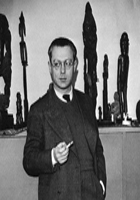 Tristan Tzara (born Samuel or Samy Rosenstock, also known as S. Samyro; April 16 1896–December 25, 1963) was a Romanian and French avant-garde poet, essayist and performance artist. Also active as a journalist, playwright, literary and art critic, composer and film director, he was known best for being one of the founders and central figures of the anti-establishment Dada movement. Under the influence of Adrian Maniu, the adolescent Tzara became interested in Symbolism and co-founded the magazine Simbolul with Ion Vinea (with whom he also wrote experimental poetry) and painter Marcel Janco. During World War I, after briefly collaborating on Vinea's Chemarea, he joined Janco in Switzerland. There, Tzara's shows at the Cabaret Voltaire and Zunfthaus zur Waag, as well as his poetry and art manifestos, became a main feature of early Dadaism. His work represented Dada's nihilistic side, in contrast with the more moderate approach favored by Hugo Ball. Tristan Tzara (born Samuel or Samy Rosenstock, also known as S. Samyro; April 16 1896–December 25, 1963) was a Romanian and French avant-garde poet, essayist and performance artist. Also active as a journalist, playwright, literary and art critic, composer and film director, he was known best for being one of the founders and central figures of the anti-establishment Dada movement. Under the influence of Adrian Maniu, the adolescent Tzara became interested in Symbolism and co-founded the magazine Simbolul with Ion Vinea (with whom he also wrote experimental poetry) and painter Marcel Janco. During World War I, after briefly collaborating on Vinea's Chemarea, he joined Janco in Switzerland. There, Tzara's shows at the Cabaret Voltaire and Zunfthaus zur Waag, as well as his poetry and art manifestos, became a main feature of early Dadaism. His work represented Dada's nihilistic side, in contrast with the more moderate approach favored by Hugo Ball.After moving to Paris in 1919, Tzara, by then one of the "presidents of Dada", joined the staff of Littérature magazine, which marked the first step in the movement's evolution toward Surrealism. He was involved in the major polemics which led to Dada's split, defending his principles against André Breton and Francis Picabia, and, in Romania, against the eclectic modernism of Vinea and Janco. This personal vision on art defined his Dadaist plays The Gas Heart (1921) and Handkerchief of Clouds (1924). A forerunner of automatist techniques, Tzara eventually rallied with Breton's Surrealism, and, under its influence, wrote his celebrated utopian poem The Approximate Man. During the final part of his career, Tzara combined his humanist and anti-fascist perspective with a communist vision, joining the Republicans in the Spanish Civil War and the French Resistance during World War II, and serving a term in the National Assembly. Having spoken in favor of liberalization in the People's Republic of Hungary just before the Revolution of 1956, he distanced himself from the French Communist Party, of which he was by then a member. In 1960, he was among the intellectuals who protested against French actions in the Algerian War. Tristan Tzara was an influential author and performer, whose contribution is credited with having created a connection from Cubism and Futurism to the Beat Generation, Situationism and various currents in rock music. The friend and collaborator of many modernist figures, he was the lover of dancer Maja Kruscek in his early youth and was later married to Swedish artist and poet Greta Knutson.
 Jean Arp Jean Arp / Hans Arp (16 September 1886 – 7 June 1966) was a German-French, or Alsatian, sculptor, painter, poet and abstract artist in other media such as torn and pasted paper. When Arp spoke in German he referred to himself as "Hans", and when he spoke in French he referred to himself as "Jean". Many people believe that he was born Hans and later changed his name to Jean, but this is not the case. Arp was born in Strasbourg. The son of a French mother and a German father, he was born during the period following the Franco-Prussian War when the area was known as Alsace-Lorraine (Elsass-Lothringen in German) after it had been returned to Germany by France. Following the return of Alsace to France at the end of World War I, French law determined that his name become Jean. In 1904, after leaving the École des Arts et Métiers in Strasbourg, he went to Paris where he published his poetry for the first time. From 1905 to 1907, Arp studied at the Kunstschule, Weimar, Germany and in 1908 went back to Paris, where he attended the Académie Julian. In 1915, he moved to Switzerland, to take advantage of Swiss neutrality. Arp later told the story of how, when he was notified to report to the German consulate, he avoided being drafted into the army: he took the paperwork he had been given and, in the first blank, wrote the date. He then wrote the date in every other space as well, then drew a line beneath them and carefully added them up. He then took off all his clothes and went to hand in his paperwork. He was told to go home. This is a tumblr account full of all of his work that i found. http://www.tumblr.com/tagged/jean%20arp?before=38 Kurt Schwitters They were artists without honour in their own land. Derided and abused, Germany's Modernists suffered public scorn and ridicule because their idea of art did not fit with Adolf Hitler's manic hatred of anything considered un-Aryan. Branded "degenerate artists", their work was paraded for the Third Reich's censure and they were banned from producing similar, or in some cases any, work at all. Now, at last, a campaign is to be launched to raise money for the world's first memorial to the artists driven into exile by the Nazis. However, the permanent tribute, costing around £30,000, will not be sited in Germany but in a secluded glade, near a dilapidated barn, in an isolated valley in the Lake District. The barn was the last workplace of the most revered of the refugee artists, Kurt Schwitters, widely considered a titan of 20th-century art, comparable in influence with Pablo Picasso and the radical French artist Marcel Duchamp. Schwitters invented the art form known as Merz (the art of everything). He pioneered collage, was an innovative graphic artist and typographer, performance artist and poet, as well as landscape and portrait painter. His use of recycled debris in his collage and sculptural installations was particularly antagonistic to the Nazis, with their championing of traditional art forms. Along with other "degenerates" his work featured in mock exhibitions staged by the Nazis. He fled Germany, first to Norway and then, when Hitler invaded, caught the last fishing boat out of Scandinavia, survived a torpedo attack and landed in Scotland. Like other "degenerate" artists, he became part of the movement that spread Modernism throughout the Western world. He died in 1948. The Lakeland memorial will comprise a glass top over the treated, upturned complex root structure of a fallen tree. Jill Rock, the artist who will produce the work, plans to call it "Roots of Modernism". Ian Hunter of Littoral Arts, which owns the Cylinders Estate where Schwitters produced his work, in what he called the Merz Barn, near Great Langdale, and where the monument will be sited, said: "As far as we know, there is no formal memorial or designated public place in which to honour or remember all the artists who were interned, executed, or forced to flee their homes and studios." The Littoral Arts Trust, which looks after the barn and sponsors the project, aims to raise £30,000 by next April. Volunteers are being sought to help with the memorial, and other work proposed at the site. more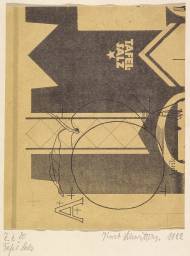 Kurt Schwitters: Tafel Salz (1922)In Hanover, the Dada spirit was embodied by a single man, Kurt Schwitters, trained under the sign of expressionnism but who, as early as 1918, had renounced figurative games to create a highly personal plastic grammar, substituting all kinds of rubbish found in public garbage dumps for noble pigments. All these cast off materials were transformed by him into admirable compositions in which colours and volumes made mysterious alliances. He called these strange paintings Merzbilder (after the central syllable of Kommerzbank) and named them by numbers in chronological order of their composition. Schwitters is the forgotten modernist. Afforded only a paragraph in many tomes and sometimes missing entirely from the chronologies that direct art-history students in a line from Impressionism to the present, the German-born Dadaist should be more than an obscurity who is perpetually rediscovered. Indeed, as a pioneer of installation art who sought to collapse the walls between painting, sculpture and the everyday detritus of a consumer society, Schwitters (June 20, 1887- January 8, 1948) has perhaps never been so vital to contemporary trends as he is today. Kurt Schwitters: Poetry and PicturesPoetry translated into English by Jerome Rothenberg and Pierre Joris.The Bricoleur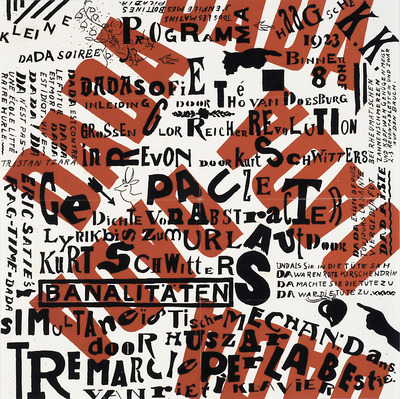 A poster designed by Kurt Schwitters and Theo van Doesburg for the "Kleine Dada Soirée," an uproarious Dada performance held in The Hague in 1922. New York, MOMA. |





















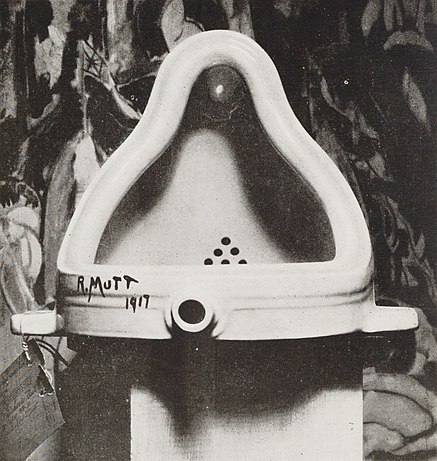
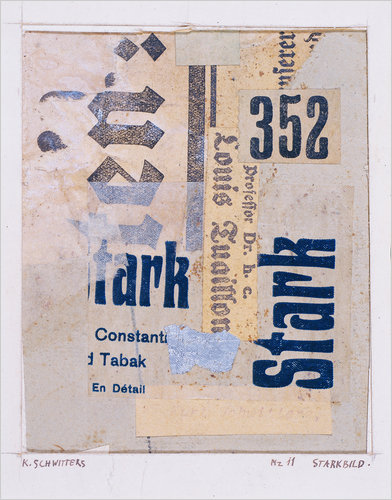
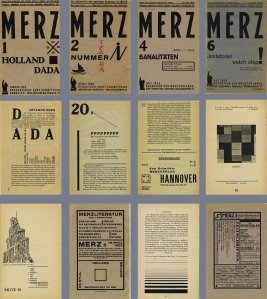
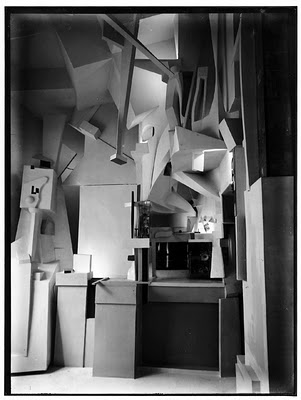
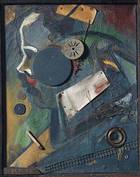
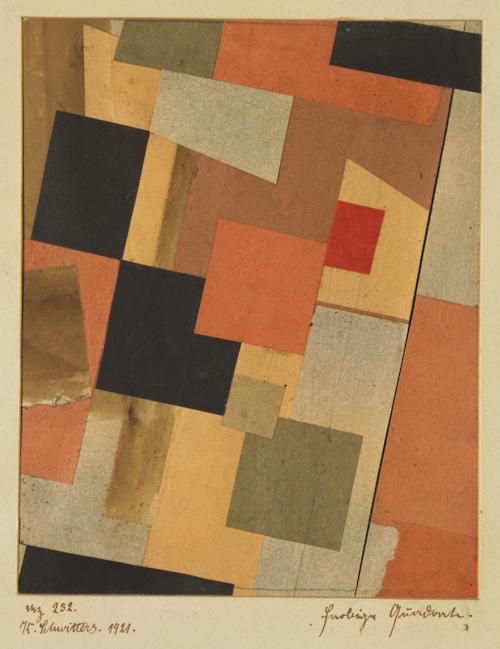














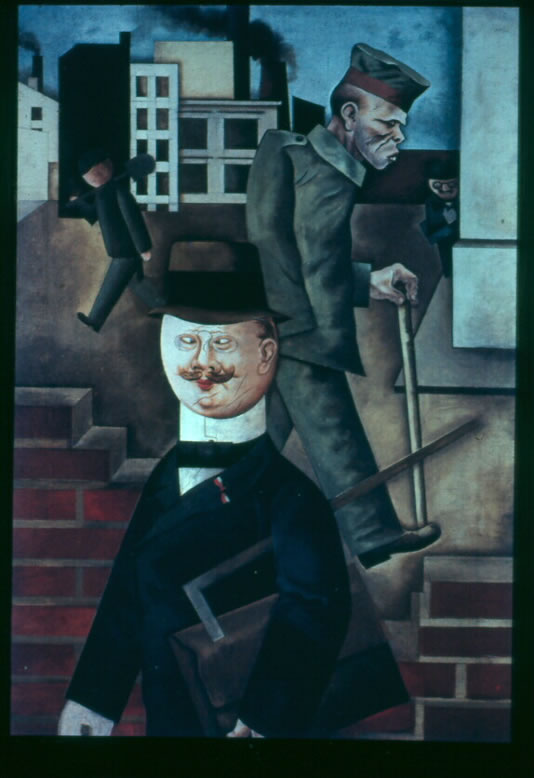
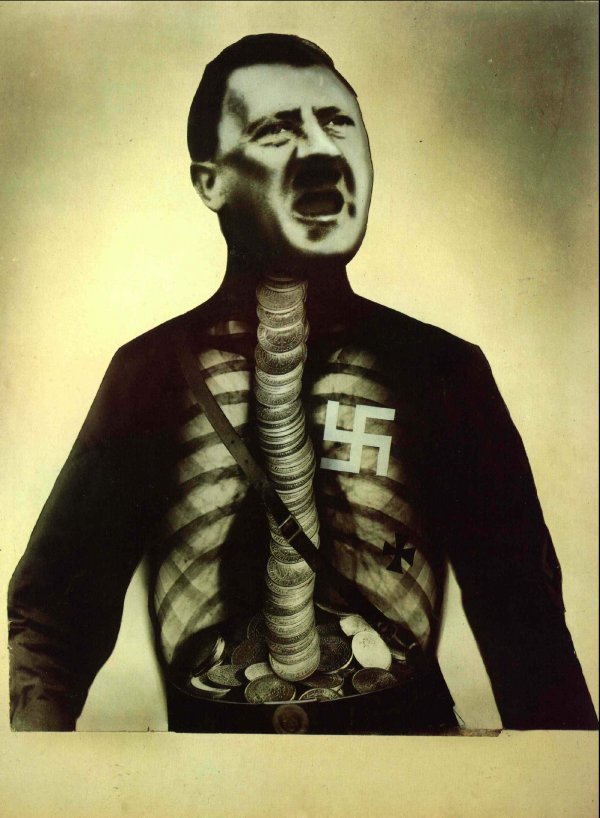
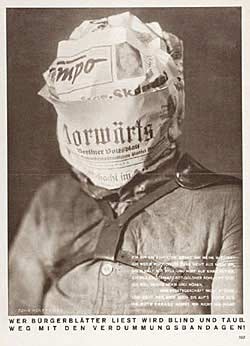




No comments:
Post a Comment